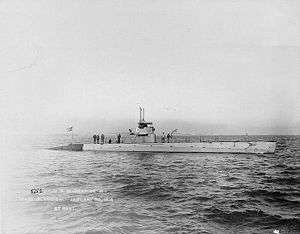USS H-1 (SS-28)
 USS H-1 | |
| History | |
|---|---|
| Name: | USS H-1 |
| Builder: | Union Iron Works, San Francisco, California |
| Laid down: | 22 March 1911, as Seawolf |
| Launched: | 6 May 1913 |
| Commissioned: | 1 December 1913 |
| Renamed: | H-1, 17 November 1911 |
| Struck: | 12 April 1920 |
| Fate: |
|
| General characteristics | |
| Type: | H-class submarine |
| Displacement: |
|
| Length: | 150 ft 4 in (45.82 m) |
| Beam: | 15 ft 10 in (4.83 m) |
| Draft: | 12 ft 5 in (3.78 m) |
| Installed power: |
|
| Propulsion: |
|
| Speed: |
|
| Test depth: | 200 ft (61 m) |
| Complement: | 25 officers and men |
| Armament: | 4 × 18 inch (450 mm) torpedo tubes (8 × torpedoes) |
USS H-1 (SS-28), the lead ship of her class of submarine of the United States Navy, was originally named Seawolf, making her the first ship of the U.S. Navy to be named for the seawolf.
Seawolf was laid down by the Union Iron Works of San Francisco, California. She was renamed on 17 November 1911, launched on 6 May 1913 sponsored by Miss Lesley Jean Makins, and commissioned at Mare Island Navy Yard on 1 December 1913, Lieutenant Henry M. Jensen in command.
Service history
The new submarine was attached to Torpedo Flotilla 2, Pacific Fleet, and operated along the West Coast out of San Pedro, California. During various exercises and patrols, she traveled the coast from Los Angeles, California to lower British Columbia, often in company with her sister ships H-2 and sometimes H-3.
Sailing from San Pedro, California on 17 October 1917, she reached New London, Connecticut on 8 November. For the remainder of World War I, she was based there and patrolled Long Island Sound, frequently with officer students from the submarine school on board.
H-1 and H-2 sailed for San Pedro, California on 6 January 1920, transiting the Panama Canal on 20 February. On 12 March, as H-1 made her way up the coast of Mexico's Baja California Peninsula, she ran aground on a shoal off Magdalena Bay.
Four men — including the commanding officer, Lieutenant Commander James R. Webb — died trying to reach shore. Vestal pulled H-1 off the rocks in the morning of 24 March, but in only 45 minutes, the submarine sank in some 50 ft (15 m) of water. Further salvage effort was abandoned. Her name was stricken from the Naval Vessel Register on 12 April, and she was sold for scrap in June 1920, but never recovered.
Her wreck was rediscovered in 1992.

References
This article incorporates text from the public domain Dictionary of American Naval Fighting Ships. The entry can be found here.
External links
- Photo gallery of USS H-1 at NavSource Naval History
- On Eternal Patrol: USS H-1